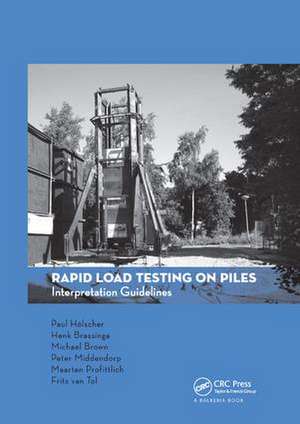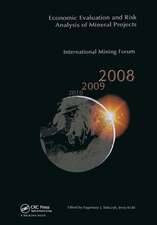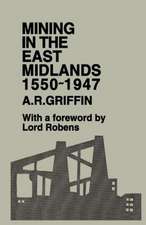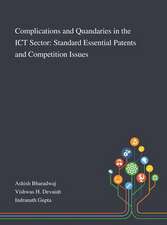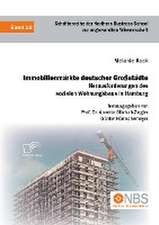Rapid Load Testing on Piles: Interpretation Guidelines
Autor Paul Holscher, Henk Brassinga, Michael Brown, Peter Middendorp, Maarten Profittlich, Frits A. van Tolen Limba Engleză Paperback – 21 noi 2018
The guidelines were related to an international standard that is drawn up by CEN and can be used in two ways:
- Straightforward interpretation of test results, chapters 1-3
- Interpretation with additional background information about the possibilities and limitations, chapters 4-8
Chapters 1 and 2 deal with the practical execution of the test and the presentation of the results. Chapter 3 gives a general overview of existing interpretation methods and refers to step-by-step descriptions of the two advised interpretation methods.
The aspects that are important for the interpretation are discussed in chapter 4, also showing that the inertia of the pile should be taken into account. In clay soil the rate effect (the dependency of strength and stiffness on loading rate) is also of importance, whereas in sand and silt the generation of pore water pressures during an RLT plays a role. The velocity of the RLT is such that the reaction of sand and silt might be considered as partially drained. These guidelines indicate how these effects can be compensated to obtain the static resistance in the final results.
Chapter 5 presents two interpretation methods (a method for piles in sand, gravel, silt and piles on rock and a method for piles in clay). For practical use, the methods are described in a step-by-step scheme in an appendix.
Preț: 568.28 lei
Preț vechi: 668.57 lei
-15% Nou
Puncte Express: 852
Preț estimativ în valută:
108.74€ • 113.54$ • 89.79£
108.74€ • 113.54$ • 89.79£
Carte tipărită la comandă
Livrare economică 15-29 aprilie
Preluare comenzi: 021 569.72.76
Specificații
ISBN-13: 9781138113770
ISBN-10: 1138113778
Pagini: 108
Dimensiuni: 174 x 246 x 6 mm
Greutate: 0.45 kg
Ediția:1
Editura: CRC Press
Colecția CRC Press
ISBN-10: 1138113778
Pagini: 108
Dimensiuni: 174 x 246 x 6 mm
Greutate: 0.45 kg
Ediția:1
Editura: CRC Press
Colecția CRC Press
Public țintă
Professional and Professional Practice & DevelopmentNotă biografică
Paul Hölscher is a specialist in the application of soil dynamics to practical problems in urban engineering. He obtained his doctorate from Delft University of Technology on the dynamic behaviour of dry and saturated soil. In his 25-year career he worked at Deltares on both fundamental research as well as practical problems for geotechnical engineers.
Henk Brassinga is senior consultant of the engineering division of the city of Rotterdam. He has been involved in many large projects in Rotterdam Harbour.
Mike Brown is currently a lecturer at the University of Dundee. He obtained his doctorate from the University of Sheffield on the rapid pile testing for piles in clay.
Peter Middendorp is director of Allnamics. He contributed to the development of pile driving analysis and the Statnamic test method. He created the basics of unloading point method and has been involved in many large rapid pile tests.
Maarten Profittlich is a consultant at Fugro. He is involved in design and testing of foundation piles worldwide. Fugro owns one of the biggest Statnamic devices world wide.
Frits van Tol is a professor of Foundation Engineering at Delft University of Technology and expertise manager at Deltares.
Henk Brassinga is senior consultant of the engineering division of the city of Rotterdam. He has been involved in many large projects in Rotterdam Harbour.
Mike Brown is currently a lecturer at the University of Dundee. He obtained his doctorate from the University of Sheffield on the rapid pile testing for piles in clay.
Peter Middendorp is director of Allnamics. He contributed to the development of pile driving analysis and the Statnamic test method. He created the basics of unloading point method and has been involved in many large rapid pile tests.
Maarten Profittlich is a consultant at Fugro. He is involved in design and testing of foundation piles worldwide. Fugro owns one of the biggest Statnamic devices world wide.
Frits van Tol is a professor of Foundation Engineering at Delft University of Technology and expertise manager at Deltares.
Cuprins
Preface Summary 1 Introduction and scope of the guidelines 2 Test execution and test results 3 General overview of interpretation methods 4 Theoretical aspects 5 Interpretation methods 6 Safety approach 7 Special aspects 8 Symbols and definitions
Descriere
A Rapid Load Test (RLT) developed to determine the initial stiffness and bearing capacity, is an economical and practical alternative for a Static Load Test (SLT) . However, the application of RLT used to be hampered by uncertainty about the interpretation of the test results. These guidelines attempt to offer clear guidance on the available analysis techniques and their reliability.
